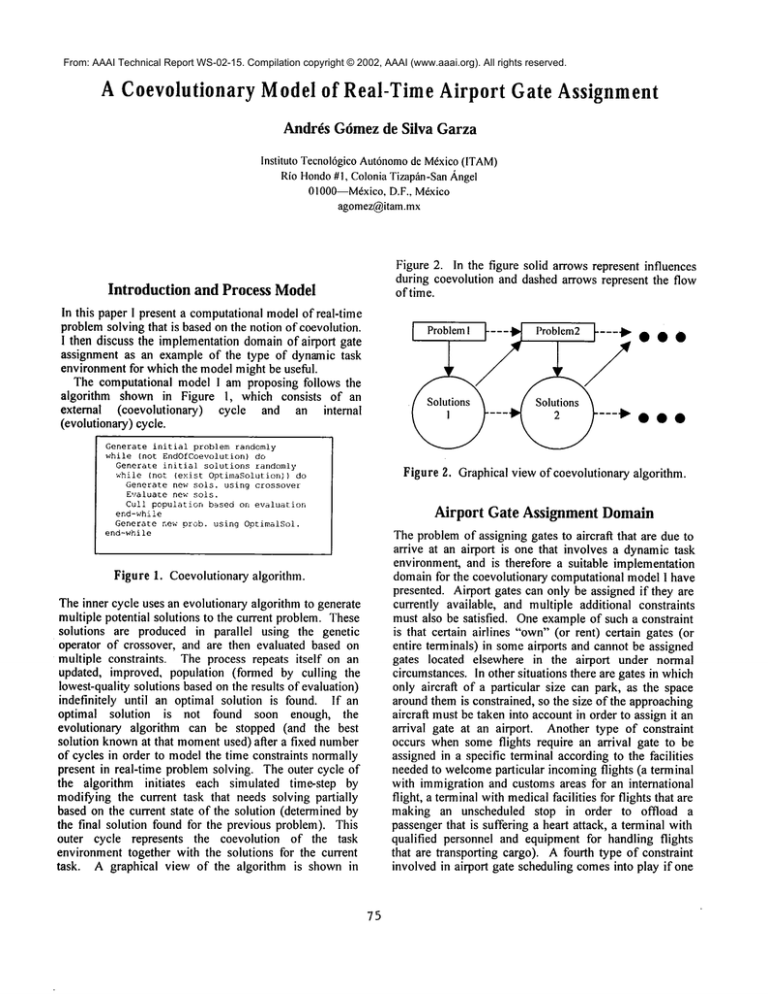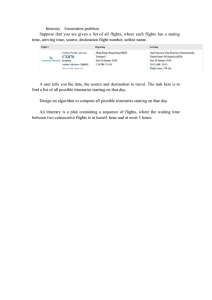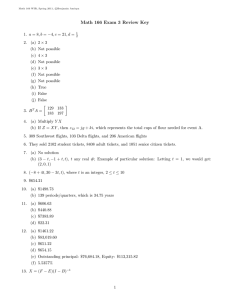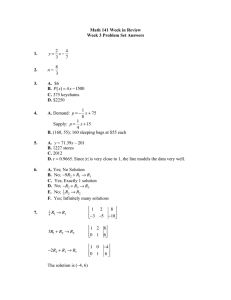
From: AAAI Technical Report WS-02-15. Compilation copyright © 2002, AAAI (www.aaai.org). All rights reserved.
A Coevolutionary Modelof Real-TimeAirport Gate Assignment
AndrOsGfmez de Silva Garza
lnstituto Tecnol6gicoAut6nomo
de M6xico(ITAM)
Rio Hondo#1, ColoniaTizapfin-SanAngel
01000~M6xico,D.F., M6xico
agomez@itam.mx
Figure 2. In the figure solid arrows represent influences
during coevolution and dashed arrows represent the flow
of time.
Introduction and Process Model
In this paper I present a computational modelof real-time
problemsolving that is based on the notion ofcoevolution.
I then discuss the implementation domainof airport gate
assignment as an example of the type of dynamic task
environment for which the modelmight be useful.
The computational model 1 am proposing follows the
algorithm shown in Figure 1, which consists of an
external (coevolutionary)
cycle and an internal
(evolutionary) cycle.
[ Problem
Generate initial problem randomly
while (not EndOfCoevolution)
Generate initial solutions randomly
while (not (exist OptimaSolution))
Generate new sols. using crossover
Evaluate new sois.
Cull population
based on evaluation
end-while
Generate new prob. using OptimalSol.
end-while
l 1----~
Problem2
~----~
¯ ¯ ¯
Figure 2. Graphical view ofcoevolutionary algorithm.
Airport Gate Assignment Domain
Figure 1. Coevolutionary algorithm.
The inner cycle uses an evolutionary algorithm to generate
multiple potential solutions to the current problem. These
solutions are produced in parallel using the genetic
operator of crossover, and are then evaluated based on
multiple constraints. The process repeats itself on an
updated, improved, population (formed by culling the
lowest-quality solutions based on the results of evaluation)
indefinitely until an optimal solution is found. If an
optimal solution is not found soon enough, the
evolutionary algorithm can be stopped (and the best
solution knownat that momentused) after a fixed number
of cycles in order to modelthe time constraints normally
present in real-time problem solving. The outer cycle of
the algorithm initiates
each simulated time-step by
modifying the current task that needs solving partially
based on the current state of the solution (determined by
the final solution found for the previous problem). This
outer cycle represents the coevolution of the task
environment together with the solutions for the current
task. A graphical view of the algorithm is shown in
75
The problemof assigning gates to aircraft that are due to
arrive at an airport is one that involves a dynamictask
environment, and is therefore a suitable implementation
domainfor the coevolutionary computational modelI have
presented. Airport gates can only be assigned if they are
currently available, and multiple additional constraints
must also be satisfied. One exampleof such a constraint
is that certain airlines "own"(or rent) certain gates (or
entire terminals) in someairports and cannot be assigned
gates located elsewhere in the airport under normal
circumstances. In other situations there are gates in which
only aircraft of a particular size can park, as the space
around them is constrained, so the size of the approaching
aircraft must be taken into account in order to assign it an
arrival gate at an airport. Another type of constraint
occurs when some flights require an arrival gate to be
assigned in a specific terminal according to the facilities
needed to welcomeparticular incomingflights (a terminal
with immigration and customs areas for an international
flight, a terminal with medicalfacilities for flights that are
making an unscheduled stop in order to offload a
passenger that is suffering a heart attack, a terminal with
qualified personnel and equipment for handling flights
that are transporting cargo). A fourth type of constraint
involved in airport gate scheduling comesinto play if one
wants to minimize the amount of time required by
incoming passengers to either depart the airport or to
connect to other flights. As soon as all these constraints
have been satisfied and appropriate gates have been
assigned to the flights that were knownto be on the verge
of landing just brief momentsbefore, morearriving flights
have approached the airspace surrounding the airport in
question, and the entire process must be repeated in order
to assign arrival gates to them. If flight arrivals at a
particular airport always followed the same patterns in
time, it wouldnot be too difficult to find once (and in the
future always reuse) an optimal solution, but delays, reroutings, changes in airline schedules, and other factors
cause airport gate assignment to be a dynamicproblem.
In terms of evolutionary algorithms, both the problem
that requires solving and the potential solutions proposed
for the problemcan be visualized as different species. The
genotype of the problem species in the airport gate
scheduling domainconsists of a string or list of flights
that are departing or arriving at any given time. The
genotype of the solution species consists of associations
between flights on the verge of arrival and free airport
gates. An evolutionary algorithm generates several
possible genotypes for the solution species in parallel,
using the genetic operator of crossover, while taking into
account the makeupof the genotype of the problemspecies
(i.e., the current problem to be solved), plus all other
constraints imposed on the task in the given situation.
Whenan acceptable solution has been found, the process
repeats itself, thus modeling the continuous nature of
aircraft arrivals and departures at a real-world airport.
Whenthis repetition occurs, the new problem genotype
which initiates another evolutionary cycle is partially
constructed based on the final solution genotype for the
previous evolutionary cycle. For instance, the part of.the
problem genotype that lists departing flights consists of
flights selected from amongthose that are currently
stationed at a departure gate, not just any randomlymadeup flights.
Therefore, both species in the domain
influence each other’s genetic makeupas they evolve over
time, somethingessential to coevolution..
KnowledgeRepresentation
The current problem that needs solving at a particular
momentin time during the simulation consists of a list or
string of flights that are on the verge of arriving or
departing at that time. Eachof these flights is a gene, and
the set of flights is the genotype of the problemspecies.
Arriving flights form part of the problem genotype
because they directly
indicate
the number and
characteristics of the flights for whicharrival gates have to
be scheduled at the present time. Departing flights form
part of the problem genotype because they indicate
changes to the current state of the airport (by freeing up
previously-occupied gates), something which indirectly
influences the range of possible solutions that maybe
proposed for the current problem.
76
In order to implement the model in the domain of
airport gate assignment the part of the problem genotype
that lists arriving flights can be generated at randomat
each coevolutionary cycle (perhaps taken from a list of
flights which normally arrive at the airport being
simulated on a typical day). The part of the problem
genotype that lists departing flights can be generated at
randomby choosing someflights currently stationed at the
airport for departure.
Each coevolutionary cycle corresponds to the existence
of one problem genotype for which a solution must be
found (i.e., to one time-step in the simulation of the
dynamic task environment). For each problem to be
solved an initial population of potential solution genotypes
can be seeded at random, and then evolved over time until
an optimal solution genotype is found. A solution
genotypeconsists of a list or string of associations between
available airport gates and the arriving flights from the
problem genotype corresponding
to the current
coevolutionary cycle. The associations are achieved
according to position, each location within a solution
genotype corresponding to a particular available gate.
Solution genes are either empty (when the solution
involves not scheduling the particular gate in the
corresponding genotype position to receive an incoming
flight) or describe flights (whichin the solution are being
assigned the gate corresponding to their genotype
position), and as such are represented in the same way as
flights are represented when they belong to problem
genotypes. Since different gates can have different
characteristics, these must also be explicitly represented,
but the gate description does not vary over time or with
each different problem, and therefore does not form part of
a solution genotype(though it is associated to the contents
of a solution genotype by the fact that each gene position
in the genotypecorrespondsto an airport gate).
The genotypesof potential solutions are generated (after
the initial,
randomly-produced population) using the
evolutionary operator of crossover to produce multiple
possible gate assignments. Resulting genotypes in which
someof the arriving flights are repeated (i.e., assigned to
more than one airport gate) as a result of the crossover
mechanismor do not appear will of course be discarded
quickly, as they will be assigned low fitness values during
evaluation.
Fitness values are assigned to each proposed solution
based on a weighted calculation
of how much each
solution satisfies each of the multiple constraints on the
problem. Someof the constraints used are static, as they
remain the same throughout the simulation (e.g., certain
gates admit only certain types of aircraft), whereasothers
are dynamic(e.g., minimizing the distance that arriving
passengers will have to walk to depart the airport and/or
transfer to other flights, which dependson the particular
requirements or characteristics of the passengers in the
arriving flight).





